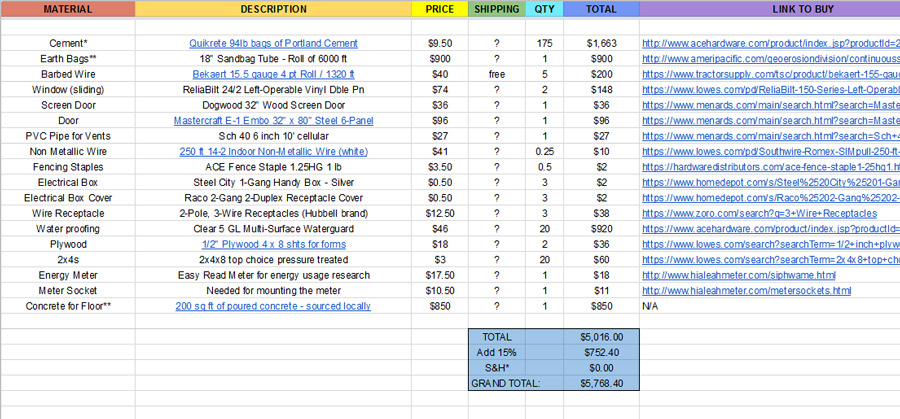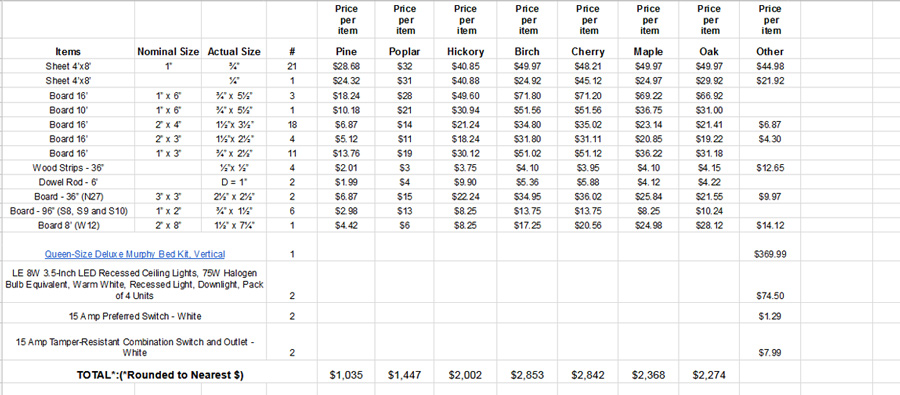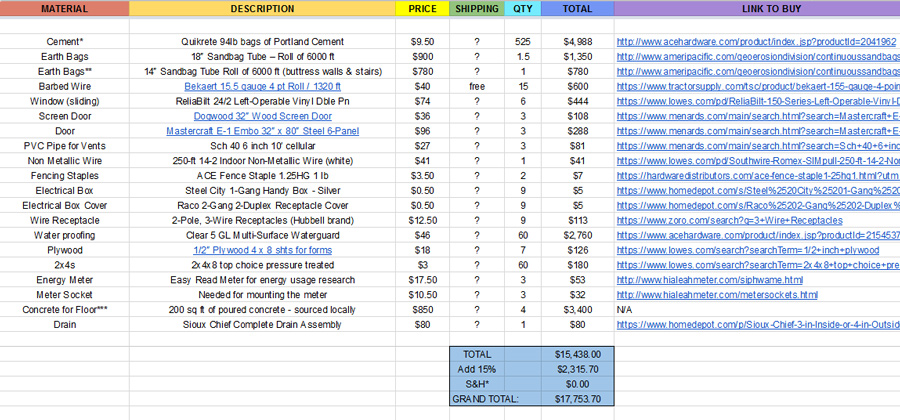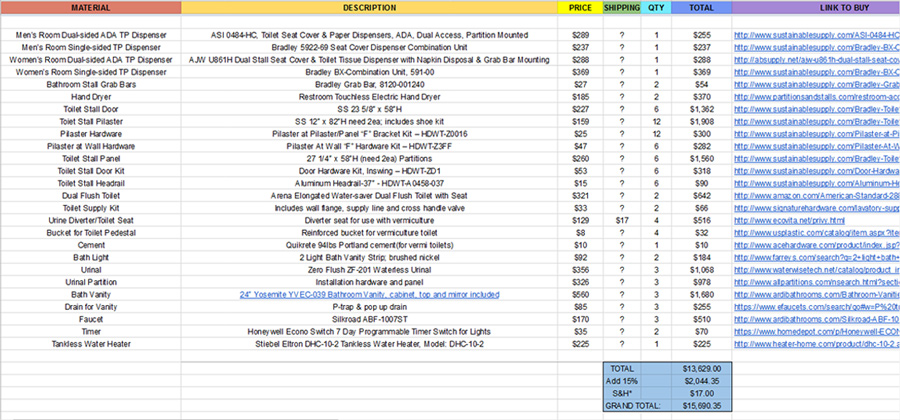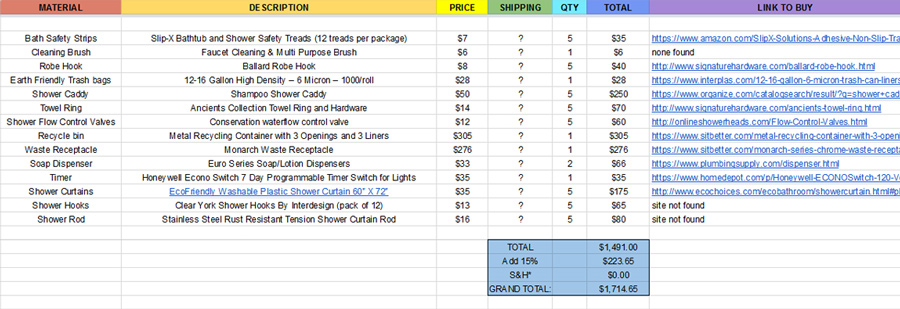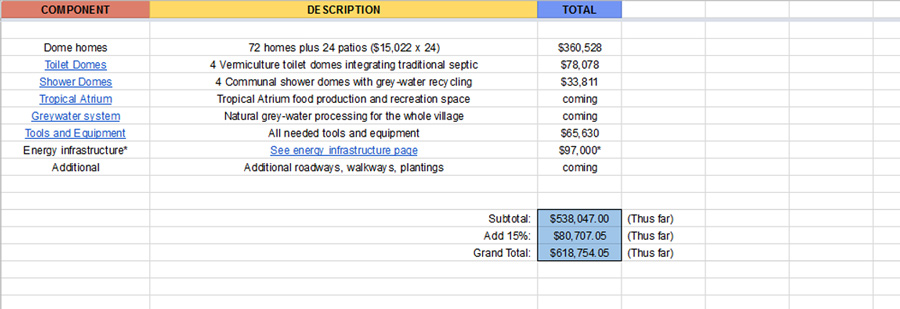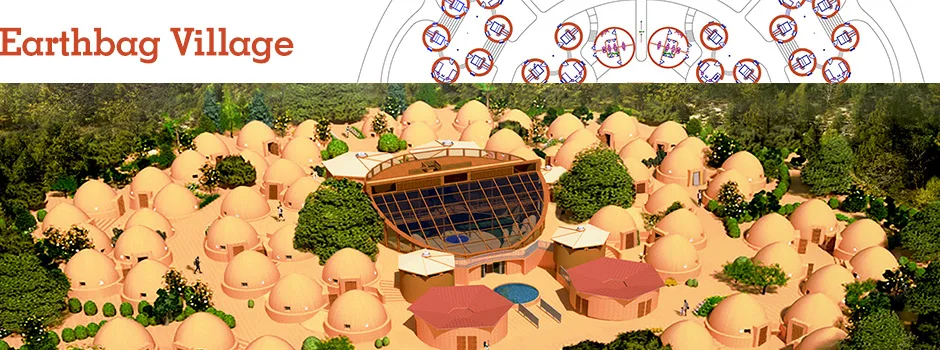
Earthbag Village Materials & Costs
This page is the open source and free-shared Earthbag home and village construction materials costs page that will evolve with the open source project-launch blueprinting of the One Community Earthbag Village (Pod 1). The goal of this page is to provide precise materials needs and costs for every component of the Earthbag Village. It is divided into the following sections:
- Materials costs for the Earthbag Village intro
- Materials costs just for building one dome home
- Materials costs just for building a 3-dome home cluster
- Materials costs just for building the vermiculture toilets
- Materials costs just for building the communal showers
- Materials costs just for building the Tropical Atrium and all its individual components
- Materials costs for building the complete Earthbag Village including all components
- Summary
- Resources
- FAQ
This page will continue to evolve until building the Earthbag Village is complete and we can definitively say exactly what materials were used for every aspect of our build. After that, we will further evolve this page with the help and data from those around the world building additional Earthbag teacher/demonstration communities, villages, and cities using our blueprints.
RELATED PAGES
WAYS TO CONTRIBUTE TO EVOLVING THIS SUSTAINABILITY COMPONENT WITH US
SUGGESTIONS | CONSULTING | MEMBERSHIP | OTHER OPTIONS
EARTHBAG VILLAGE MATERIALS & COSTS
![]() This page is specifically for the materials costs details of the Earthbag Village. As part of our global transformation approach to Highest Good housing, our goal is to continuously update this page with resources to make Earthbag construction materials sourcing and acquisition as easy as possible. For details on the other aspects of the Earthbag Village (building plans, tools and equipment, time investment, etc.) visit the complete EARTHBAG VILLAGE OPEN SOURCE HUB. That hub also includes links to the additional open source hubs related to the Earthbag Village (showers and toilets, Tropical Atrium, water catchment, greywater system, etc.).
This page is specifically for the materials costs details of the Earthbag Village. As part of our global transformation approach to Highest Good housing, our goal is to continuously update this page with resources to make Earthbag construction materials sourcing and acquisition as easy as possible. For details on the other aspects of the Earthbag Village (building plans, tools and equipment, time investment, etc.) visit the complete EARTHBAG VILLAGE OPEN SOURCE HUB. That hub also includes links to the additional open source hubs related to the Earthbag Village (showers and toilets, Tropical Atrium, water catchment, greywater system, etc.).
MATERIALS COSTS FOR
A SINGLE DOME
 Here are the initial materials costs for one 200 sq ft (18.581 sq m) Earthbag dome, updated details are coming with more specifics. We expect the final cost to be around $10,000 per dome. As part of our open source purpose, we are constantly seeking to improve this resource. If you are a materials provider, or know a materials provider that can help us reduce prices for everyone, please have them contact us through our Partners Page. If you are an experienced builder with a suggestion for making this resource better, please contact us through our Suggestions Page. Please also email us if you find any broken links.
Here are the initial materials costs for one 200 sq ft (18.581 sq m) Earthbag dome, updated details are coming with more specifics. We expect the final cost to be around $10,000 per dome. As part of our open source purpose, we are constantly seeking to improve this resource. If you are a materials provider, or know a materials provider that can help us reduce prices for everyone, please have them contact us through our Partners Page. If you are an experienced builder with a suggestion for making this resource better, please contact us through our Suggestions Page. Please also email us if you find any broken links.
* Note that cement needs are specific to sandy soils and the goal is 10-15% small stones and gravel, 80-90% coarse and fine sand, and 5-10% cement. Lime can be used for sandy soils with some clay and the goal is then 10-15% small stones and gravel, 40-80% coarse and fine sand, 5-20% clay, and 10-20% lime. In the case of soils with large amounts of clay the goal is 10-15% small stones and gravel, 40-80% coarse and fine sand, 20-40% clay, and 10-20% lime. It is also noted that cement is not considered a very sustainable building material and One Community will be seeking over the course of this build to explore other alternatives that will meet our engineering, permitting, and materials availability needs. CLICK HERE for a resource guide discussing what many of these alternatives are.
** The amount of sandbag tubing needed for a 200 sq ft (18.581 sq m) structure is 3,300 ft (1.0058 km). The additional bag listed here is for the buttress wall needing to be built 1 bag line (6″/15.24 cm) above the spring line (3.5’/1.067 m). The sandbag tubing also comes only in 6000 ft (1.828 km) rolls.
*** We’ll be demonstrating and open source sharing a variety of earthen and other DIY floors in each of the 75 structures of the Earthbag Village. These floors will be cheaper, more sustainable, and more attractive than concrete. The patios, however, will be concrete and, for simplicity of pricing, we included the floors of the homes as concrete also.
**** 30% has been added to cover shipping and handling, tax, and anything else we’ve missed. We will replace these numbers with “hard” numbers once we have built 10 domes.
COMPLETE MATERIALS COSTS FOR THE MURPHY BED CUSTOM FURNITURE

200 square foot Earthbag construction living dome custom Murphy bed furniture design – click image for details
Here is the complete parts list and materials costs comparing a variety of different types of wood that could be used to construct this design. Prices and availability will probably differ based on your location but this gives a basic idea of cost differences. Consider using recycled wood if you’d like to reduce these prices.
MATERIALS COSTS FOR
A CLUSTER OF 3 DOMES
 Here are the materials costs for three 200 sq ft (18.581 sq m) Earthbag dome homes with central patio. There are eight of these 3-dome clusters in the village and eight 6-dome clusters that share a patio that will cost slightly less than the patio of two 3-dome clusters. As part of our open source purpose, we are constantly seeking to improve this resource. If you are a materials provider, or know a materials provider that can help us reduce prices for everyone, please have them contact us through our Partners Page. If you are an experienced builder with a suggestion for making this resource better, please contact us through our Suggestions Page. Please also email us if you find any broken links.
Here are the materials costs for three 200 sq ft (18.581 sq m) Earthbag dome homes with central patio. There are eight of these 3-dome clusters in the village and eight 6-dome clusters that share a patio that will cost slightly less than the patio of two 3-dome clusters. As part of our open source purpose, we are constantly seeking to improve this resource. If you are a materials provider, or know a materials provider that can help us reduce prices for everyone, please have them contact us through our Partners Page. If you are an experienced builder with a suggestion for making this resource better, please contact us through our Suggestions Page. Please also email us if you find any broken links.
* Note that cement needs are specific to sandy soils and the goal is 10-15% small stones and gravel, 80-90% coarse and fine sand, and 5-10% cement. Lime can be used for sandy soils with some clay and the goal is then 10-15% small stones and gravel, 40-80% coarse and fine sand, 5-20% clay, and 10-20% lime. In the case of soils with large amounts of clay the goal is 10-15% small stones and gravel, 40-80% coarse and fine sand, 20-40% clay, and 10-20% lime. It is also noted that cement is not considered a very sustainable building material and One Community will be seeking over the course of this build to explore other alternatives that will meet our engineering, permitting, and materials availability needs. CLICK HERE for a resource guide discussing what many of these alternatives are.
** The 14″ (35.56 cm) sandbag tubing is for the buttress wall needing to be built 1 bag line (6″/15.24 cm) above the spring line (3.5’/1.067 m), the stairs, and benches seen in the plans here (click).
*** We’ll be demonstrating and open source sharing a variety of earthen and other DIY floors in each of the 75 structures of the Earthbag Village. These floors will be cheaper, more sustainable, and more attractive than concrete. The patios, however, will be concrete and, for simplicity of pricing, we included the floors of the homes as concrete also.
**** 30% has been added to cover shipping and handling, tax, and anything else we’ve missed. Our goal is to bring these prices down through partnerships and on-going research. We will replace these numbers with “hard” numbers once we have built 10 domes.
MATERIALS COSTS FOR THE
VERMICULTURE TOILET
 Here are the materials costs for the vermiculture toilet incorporating traditional septic. The goal of this communal toilet model is to open source share everything needed to duplicate a 6-stall eco-toilet model that can be built in almost any county because it also incorporates traditional septic. Once we can prove the effectiveness and safety of the vermiculture waste processing method, we will be able to phase out the traditional septic on these toilets while building new toilets that don’t need a traditional septic.
Here are the materials costs for the vermiculture toilet incorporating traditional septic. The goal of this communal toilet model is to open source share everything needed to duplicate a 6-stall eco-toilet model that can be built in almost any county because it also incorporates traditional septic. Once we can prove the effectiveness and safety of the vermiculture waste processing method, we will be able to phase out the traditional septic on these toilets while building new toilets that don’t need a traditional septic.
EVERYTHING INSIDE THE BATHROOM
* 30% has been added to cover shipping and handling, tax, and anything else we’ve missed. Our goal is to bring these prices down through partnerships and on-going research. We will replace these numbers with “hard” numbers once we have built the first complete bathroom. We will also be seeking increasingly more ethical and sustainable options for everything through our globally collaborative Highest Good lifestyle considerations model.
** This grand total is for 1 bathroom. For the complete Earthbag Village we will build 4 of these for an initial projected total cost of $65,796.
ACCESSORIES
Accessories are the non-essential items that are still a part of most public bathrooms.
* 30% has been added to cover shipping and handling, tax, and anything else we’ve missed. Our goal is to bring these prices down through partnerships and on-going research. We will replace these numbers with “hard” numbers once we have built and stocked the first complete bathroom. We will also be seeking increasingly more ethical and sustainable options for everything through our globally collaborative Highest Good lifestyle considerations model.
** This grand total is for 1 bathroom. For the complete Earthbag Village we will stock 4 of these for an initial projected total cost of $9,282.
TRADITIONAL SEPTIC COSTS
| MATERIAL | DESCRIPTION | LINK TO BUY | PRICE | QTY | TOTAL |
| Septic Tank | 1500 Gallons: Locally sourced and complete with all accessories | N/A | $1500 | 2 | $3,000 |
COMPLETE VERMICULTURE SETUP COSTS
Coming soon… (Click here if you’d like to help complete this piece)
MATERIALS COSTS FOR
THE COMMUNAL SHOWER DESIGNS
 Here are the materials costs for the communal showers. The goal of this section is to open source share everything needed to duplicate an eco-friendly communal shower option with 5 shower stalls including 1 ADA compliant stall.
Here are the materials costs for the communal showers. The goal of this section is to open source share everything needed to duplicate an eco-friendly communal shower option with 5 shower stalls including 1 ADA compliant stall.
EVERYTHING INSIDE THE SHOWER
* 30% has been added to cover shipping and handling, tax, and anything else we’ve missed. Our goal is to bring these prices down through partnerships and on-going research. We will replace these numbers with “hard” numbers once we have built the first complete shower. We will also be seeking increasingly more ethical and sustainable options for everything through our globally collaborative Highest Good lifestyle considerations model.
** This grand total is for 1 communal shower. For the complete Earthbag Village we will build 4 of these for an initial projected total cost of $26,551.
ACCESSORIES
Accessories are the non-essential items that are still a part of most shared-use shower facilities.
* 30% has been added to cover shipping and handling, tax, and anything else we’ve missed. Our goal is to bring these prices down through partnerships and on-going research. We will replace these numbers with “hard” numbers once we have built and stocked the first shower is complete and stocked. We will also be seeking increasingly more ethical and sustainable options for everything through our globally collaborative Highest Good lifestyle considerations model.
** This grand total is for 1 shower. For the complete Earthbag Village we will stock 4 of these for an initial projected total cost of $7,260.
MATERIALS COSTS FOR
THE TROPICAL ATRIUM
 We are now working on the same level of detail as above for the Tropical Atrium materials.
We are now working on the same level of detail as above for the Tropical Atrium materials.
Coming soon… (Click here if you’d like to help complete this piece)
MATERIALS COSTS FOR
THE COMPLETE VILLAGE
 Once all of the above are complete we will list here a detailed cost analysis for the Earthbag Village and all of its components that we will engage as an on-going process of updating and refining until the entire build is complete and we can give a definitive and final materials analysis and cost spreadsheet for the complete village and each individual component, along with the best places that we found for purchasing everything.
Once all of the above are complete we will list here a detailed cost analysis for the Earthbag Village and all of its components that we will engage as an on-going process of updating and refining until the entire build is complete and we can give a definitive and final materials analysis and cost spreadsheet for the complete village and each individual component, along with the best places that we found for purchasing everything.
* Note that this number reflects 20% of our energy infrastructure cost needed to operate the Earthbag Village. The total energy infrastructure cost includes the Earthbag Village, the Duplicable City Center, and our Phase I Food Infrastructure and can be found on the energy infrastructure page.
SUMMARY
![]() The purpose of our organization is to make the building of self-propagating self-sufficient teacher/demonstration communities, villages, and cities as easy as possible. It is also to demonstrate that food, housing, and energy for 100 people can be built for less than the cost of supplying these things for just 10 people in the current system. Clearly defining exactly what the materials costs are for duplication of every component of the Earthbag Village is an important part of achieving this. This page is the results of our research and it will evolve with even more details as we build the Earthbag Village and identify through our experience the best materials and partners that can reduce the price for acquiring all needed tools and equipment. We will open source these details here as they evolve.
The purpose of our organization is to make the building of self-propagating self-sufficient teacher/demonstration communities, villages, and cities as easy as possible. It is also to demonstrate that food, housing, and energy for 100 people can be built for less than the cost of supplying these things for just 10 people in the current system. Clearly defining exactly what the materials costs are for duplication of every component of the Earthbag Village is an important part of achieving this. This page is the results of our research and it will evolve with even more details as we build the Earthbag Village and identify through our experience the best materials and partners that can reduce the price for acquiring all needed tools and equipment. We will open source these details here as they evolve.
RESOURCES
- Global suppliers of bags resource
- Earthwall engineering documentation
- Resource of structural integrity resources
- Example of how affordably these structures can be built in a third-world country (see bottom of article)
FREQUENTLY ANSWERED QUESTIONS
Q: What is the purpose of the Earthbag Village?
Please see the complete Earthbag Village open source hub: Click Here
Q: Why aren’t you using _______ material? It’s more sustainable.
Please use our Suggestions Page to share these ideas with us. Our goal is to build as sustainably as possible and we are interested in any and all ideas people have for how to do this. Even if your idea doesn’t meet our immediate engineering, materials availability, or other needs, we’d still like to know about it because we’ll be working indefinitely as an organization to explore, test, and open source share as many alternative and sustainable materials, approaches, and methodologies as possible. Doing this is an essential part of our global-change methodology and desire to provide the necessary data and demonstrations of safety and effectiveness needed so more counties (and The International Building Code) begin to recognize and accept these sustainable options.
Q: How do you intend to keep track of all the materials for each component?
We will use the community project management software we are developing to log everything as it is used and appoint a project foreman to oversee and double check the details.
Q: How do you intend to help bring prices down to facilitate duplication of your models as teacher/demonstration villages?
We have a Win-Win-Win-Win partnering philosophy combined with a significant marketing and promotional engine that we feel brings value to any partnership. We are using these tools and resources to seek partners with the global distribution capability who see the free marketing and new and expanding customer base we will provide as beneficial enough to be willing to reduce their consumer prices and individual profit in favor of volume sales and supporting global change.
 One Community
One Community





